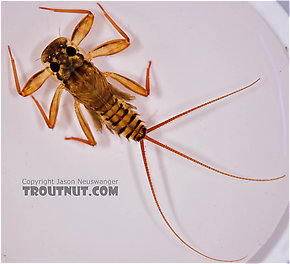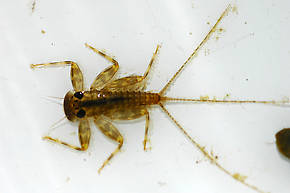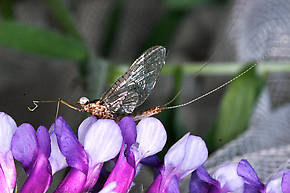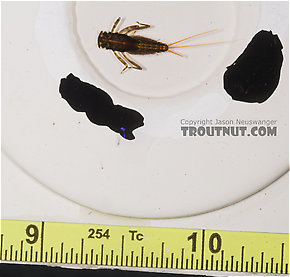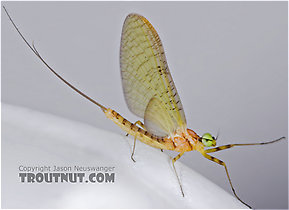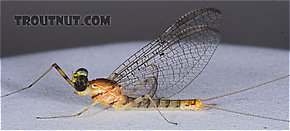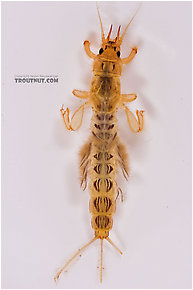Blog & Latest Updates
Fly Fishing Articles
Insects by Common Name


Gray Foxes
Scientific Names
Like most common names, "Gray Fox" can refer to more than one taxon. They're previewed below, along with 13 specimens. For more detail click through to the scientific names.
Mayfly Species Maccaffertium vicarium
These are often called Gray Foxes.
In the East and Midwest this is one of the most important hatches of the Spring. They are large flies which emerge sporadically, making for long days of good fishing.
This species contains the two classic Eastern hatches formerly known as Stenonema vicarium and Stenonema fuscum, the "March Brown" and "Gray Fox." Entomologists have discovered that these mayflies belong to the same species, but they still display differences in appearance which the trout notice easily. Anglers should be prepared to imitate both types.
This species contains the two classic Eastern hatches formerly known as Stenonema vicarium and Stenonema fuscum, the "March Brown" and "Gray Fox." Entomologists have discovered that these mayflies belong to the same species, but they still display differences in appearance which the trout notice easily. Anglers should be prepared to imitate both types.
Male Maccaffertium vicarium (March Brown) Mayfly Dun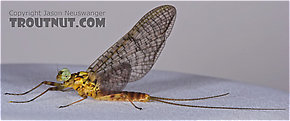 View 10 PicturesI collected this mayfly on the same trip as a female of the same species. After these photos it molted into a spinner. This is the form of Maccaffertium vicarium which anglers call the "Gray Fox."
View 10 PicturesI collected this mayfly on the same trip as a female of the same species. After these photos it molted into a spinner. This is the form of Maccaffertium vicarium which anglers call the "Gray Fox."
 View 10 PicturesI collected this mayfly on the same trip as a female of the same species. After these photos it molted into a spinner. This is the form of Maccaffertium vicarium which anglers call the "Gray Fox."
View 10 PicturesI collected this mayfly on the same trip as a female of the same species. After these photos it molted into a spinner. This is the form of Maccaffertium vicarium which anglers call the "Gray Fox."Female Maccaffertium vicarium (March Brown) Mayfly Spinner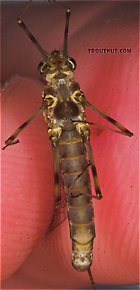 View 7 PicturesI collected this mayfly on the same trip as a male of the same species. They are Maccaffertium vicarium mayflies of the type formerly known as Stenonema fuscom, the "Gray Fox."
View 7 PicturesI collected this mayfly on the same trip as a male of the same species. They are Maccaffertium vicarium mayflies of the type formerly known as Stenonema fuscom, the "Gray Fox."
 View 7 PicturesI collected this mayfly on the same trip as a male of the same species. They are Maccaffertium vicarium mayflies of the type formerly known as Stenonema fuscom, the "Gray Fox."
View 7 PicturesI collected this mayfly on the same trip as a male of the same species. They are Maccaffertium vicarium mayflies of the type formerly known as Stenonema fuscom, the "Gray Fox."See 16 more specimens...
Mayfly Species Heptagenia solitaria
These are sometimes called Gray Foxes.
Heptagenia solitaria (Ginger Quill) Mayfly Adult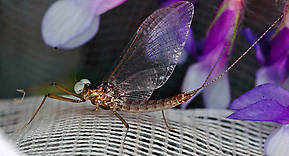 View 4 PicturesThis species is common in the Flathead River below Kerr Day. The river here is fairly warm with a cobble and boulder bottom with heavy periphyton at times. This species is not common elsewhere in western Montana.
View 4 PicturesThis species is common in the Flathead River below Kerr Day. The river here is fairly warm with a cobble and boulder bottom with heavy periphyton at times. This species is not common elsewhere in western Montana.
 View 4 PicturesThis species is common in the Flathead River below Kerr Day. The river here is fairly warm with a cobble and boulder bottom with heavy periphyton at times. This species is not common elsewhere in western Montana.
View 4 PicturesThis species is common in the Flathead River below Kerr Day. The river here is fairly warm with a cobble and boulder bottom with heavy periphyton at times. This species is not common elsewhere in western Montana.Mayfly Genus Stenacron
These are very rarely called Gray Foxes.
The species in this genus were formerly classified in Stenonema. See the genus Maccaffertium for details. Only one species, Stenacron interpunctatum, is important to fly fishermen. See its page for details.
See 5 more specimens...
Mayfly Species Stenacron interpunctatum
These are very rarely called Gray Foxes.
This is the best of the sporadic summer hatches known to anglers as Light Cahills. It was formerly known as Stenonema canadense and is considered by most angling historians as the model for that classic Catskill pattern.
Female Stenacron interpunctatum (Light Cahill) Mayfly Dun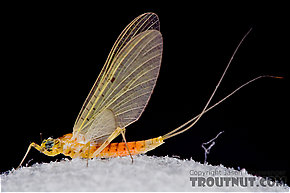 View 6 PicturesThis is a fairly small late-season female Stenacron dun.
View 6 PicturesThis is a fairly small late-season female Stenacron dun.
 View 6 PicturesThis is a fairly small late-season female Stenacron dun.
View 6 PicturesThis is a fairly small late-season female Stenacron dun.Mayfly Species Ephemera varia
These are very rarely called Gray Foxes.
This is an excellent hatch of a different character than its Ephemera brethren. Rather than emerging in a flurry of activity within a week, the Ephemera varia flies may last for more than a month in a single place.
Female Ephemera varia (Yellow Drake) Mayfly Dun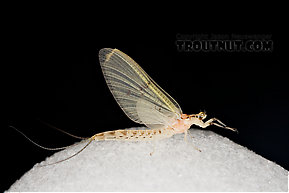 View 7 PicturesThis yellow drake dun hatched out of my aquarium over a month before her brethren in the wild are slated to emerge. She seems a bit small, and that might be the reason.
View 7 PicturesThis yellow drake dun hatched out of my aquarium over a month before her brethren in the wild are slated to emerge. She seems a bit small, and that might be the reason.
 View 7 PicturesThis yellow drake dun hatched out of my aquarium over a month before her brethren in the wild are slated to emerge. She seems a bit small, and that might be the reason.
View 7 PicturesThis yellow drake dun hatched out of my aquarium over a month before her brethren in the wild are slated to emerge. She seems a bit small, and that might be the reason.Female Ephemera varia (Yellow Drake) Mayfly Spinner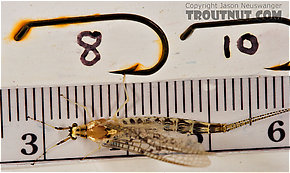 View 6 PicturesI found this female spinner ovipositing in a small stream. She came along while I was playing a trout -- every good bug seemed to do that last night! I didn't have my bug net, so I caught the trout in my landing net, released the trout, and caught the mayfly in my landing net. Her wing got a bit messed up from that.
View 6 PicturesI found this female spinner ovipositing in a small stream. She came along while I was playing a trout -- every good bug seemed to do that last night! I didn't have my bug net, so I caught the trout in my landing net, released the trout, and caught the mayfly in my landing net. Her wing got a bit messed up from that.
 View 6 PicturesI found this female spinner ovipositing in a small stream. She came along while I was playing a trout -- every good bug seemed to do that last night! I didn't have my bug net, so I caught the trout in my landing net, released the trout, and caught the mayfly in my landing net. Her wing got a bit messed up from that.
View 6 PicturesI found this female spinner ovipositing in a small stream. She came along while I was playing a trout -- every good bug seemed to do that last night! I didn't have my bug net, so I caught the trout in my landing net, released the trout, and caught the mayfly in my landing net. Her wing got a bit messed up from that.Top 10 Fly Hatches
Top Gift Shop Designs
Eat mayflies.
Top Insect Specimens
Miscellaneous Sites
Troutnut.com is copyright © 2004-2024 Jason
Neuswanger (email Jason). See my FAQ for information about use of my images.
 privacy policy
privacy policy

